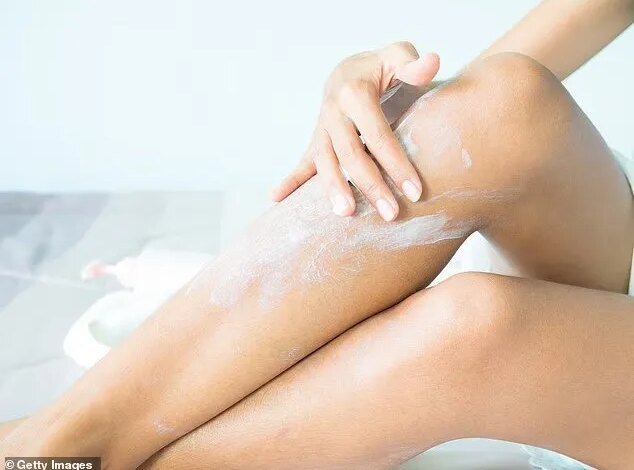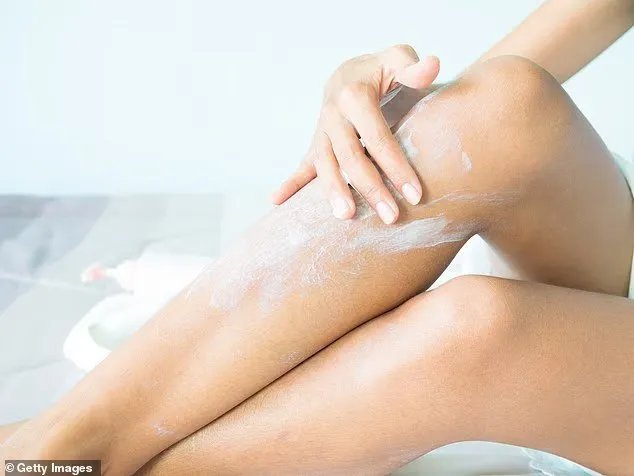Rough, ugly bumps on arms and legs haunt so many women:…

Rough, ugly bumps on arms and legs haunt so many women:…
Daily Mail journalists select and curate the products that feature on our site. If you make a purchase via links on this page we will earn commission – learn more
If you suffer from those persistent little bumps on your arms, legs or cheeks, it may be keratosis pilaris. ‘Keratosis pilaris, or KP, is a common, harmless skin condition that’s often described as “chicken skin,”’ explains London-based dermatologist Dr Anjali Mahto.
‘It’s caused by the accumulation of keratin, a protein in the skin, which blocks hair follicles and results in small, rough, flesh-coloured or red bumps on the outer aspects of your upper arms, thighs or buttocks.’ It can also occur in other areas of the body, though less frequently.
While KP rarely causes pain or itching, mild irritation can occur in some cases. If the condition is irritated, the skin surrounding the bumps may be dry or slightly red.
What causes KP?
‘The exact cause of keratosis pilaris is not fully understood, but there is a strong genetic component, meaning it often runs in families,’ says Dr Mahto. It’s also associated with dry skin and certain skin conditions, such as eczema, and can worsen during the winter.
What are the best treatments for KP?
There’s no magic cure. ‘Treatments for keratosis pilaris focus on softening the keratin plugs and improving skin texture,’ says Dr Mahto. The most effective way to smooth those rough bumps is with regular, gentle exfoliation using products that contain active ingredients. She recommends topical creams formulated with lactic acid, urea or salicylic acid to help refine the skin’s surface and restore softness over time.
Consistency is key when it comes to KP
Consistency is key when it comes to KP. ‘Daily application over several weeks to months is needed to see a real difference,’ explains Dr Mahto. ‘Improvements tend to be gradual, and while treatments can smooth roughness and calm redness, the results often fade if you stop using them.’ Keeping the skin moisturised and sticking to a regular routine can help prevent flare-ups – especially when the weather turns cold.
The best keratosis pilaris body washes
Why we love it: This soap-free shower gel is formulated for dry, rough, irritated or sensitive skin. Key ingredients like urea, niacinamide and panthenol in the formula aim to cleanse gently, provide hydration, support the skin barrier and deliver mild exfoliation without over-drying.
Active ingredients: 5% urea, niacinamide
Fragrance free: Yes
Why we love it: Great for those with uneven texture, oily or stressed skin, the blend of salicylic acid, white willow bark and green tea extract in this gel-based body wash works to gently exfoliate, smooth and soften the skin, while the aloe vera provides hydration.
Active ingredient: Salicylic acid (BHA)
Fragrance free: No
Why we love it: Formulated for KP-prone skin, this body wash contains 0.5% salicylic acid to dissolve keratin plugs and gently exfoliate the skin, 1% niacinamide to rebuild the skin barrier, and a blend of amino acids, AHAs, antioxidants and proteins to prevent dryness and irritation.
Active ingredients: Salicylic acid (BHA), 1% niacinamide
Fragrance free: No
The best keratosis pilaris body serums
Why we love it: This milky body serum is a deeply hydrating and smoothing treatment that helps to soften rough, dry or textured skin while supporting a strong and healthy skin barrier. It combines gentle exfoliation (thanks to 5% urea) with barrier-replenishing and moisture-locking ingredients such as glycerin and amino acids.
Active ingredient: 5% urea
Fragrance free: Yes
Why we love it: A water-based body serum for those with blemish-prone, congested or uneven skin, the formula contains 0.5% salicylic acid to smooth texture, help clear breakouts on the body and reduce the look of clogged pores, while glycerin draws moisture into skin and keeps it hydrated.
Active ingredient: 0.5% salicylic acid (BHA)
Fragrance free: Yes
Why we love it: This lightweight body serum is made for clarifying and treating rough or bumpy skin. The succinic acid in the formula exfoliates gently, while the barrier lipid complex soothes irritation, strengthens the skin barrier and hydrates – all without stripping the skin.
Active ingredient: Succinic acid
Fragrance free: No
The best keratosis pilaris body lotions
Why we love it: A deeply hydrating treatment for KP-prone, rough and extremely dry skin, this body cream contains lactic acid to gently exfoliate, a blend of urea, allantoin, amino acids and proteins to restore the skin barrier, and omega oils, shea butter, cocoa butter and squalane to nourish and soften the skin.
Active ingredient: Lactic acid (AHA), urea
Fragrance free: No
Why we love it: This fast-absorbing body cream has been formulated with an exfoliating and hydrating cocktail of 10% urea, salicylic acid, lactic acid, niacinamide, hyaluronic acid and ceramides to address rough, dry and bumpy skin and restore its natural barrier.
Active ingredients: 10% urea, salicylic acid (BHA), lactic acid (AHA), niacinamide, hyaluronic acid
Fragrance free: Yes
Why we love it: Containing chemical exfoliants like lactic acid to reduce the appearance of rough bumps, and hydrating ingredients like urea, colloidal oatmeal and ceramides to draw in moisture, this multitasking body lotion will improve dryness, redness and uneven texture.
Active ingredient: 10% lactic acid (AHA), urea
Fragrance free: No
What should you look for in a KP treatment?
For best results, follow Dr Mahto’s advice and look for moisturisers or creams containing ingredients known as keratolytic agents – they help exfoliate the top layer of skin. The most effective keratolytic ingredients include urea, lactic acid, salicylic acid and glycolic acid. Ideally these ingredients will be paired with a moisturising base to prevent dryness.
Can you ever get rid of KP completely?
The short answer is no. Keratosis pilaris is more of a condition that is managed rather than ‘cured’, says Dr Mahto. ‘It tends to wax and wane over time.’ Treatments can significantly improve the appearance of the skin, making it smoother and less noticeable, but bumps may recur if maintenance is discontinued.
When should you see a dermatologist?
Most cases of KP don’t require a dermatologist. However, you should consider a consultation if the condition is severe, itchy, inflamed or affecting your self-confidence – it may also not be KP, so seeing a dermatologist can ensure an accurate diagnosis.
Share or comment on this article:
Rough, ugly bumps on arms and legs haunt so many women: Now a top dermatologist explains what causes the condition – and the surefire ways to banish it for good
Disclaimer: This news article has been republished exactly as it appeared on its original source, without any modification.
We do not take any responsibility for its content, which remains solely the responsibility of the original publisher.
Author: uaetodaynews
Published on: 2025-10-22 04:08:00
Source: uaetodaynews.com



